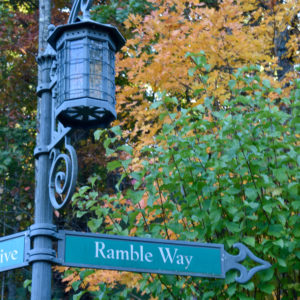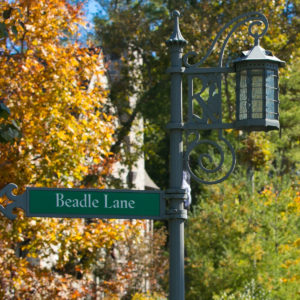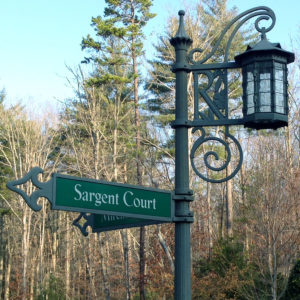
The Ramble Biltmore Forest is a community where every detail matters. The Ramble is unique – it is a place where nature, history, and community not only coexist, but complement each other. The Ramble was patterned after conservation principles created by Frederick Law Olmsted and the property was part of George W. Vanderbilt’s original estate. We are pleased to share the history behind some of the street names in The Ramble, which provides a window into some of the influential visionaries who provided inspiration for community’s design and the thought and care given to every detail in the community.

Like the community name, the Ramble Way street name derives from the lush Central Park woodland, known as the Ramble. Frederick Law Olmsted co-designed Central Park and is widely considered to be the father of American landscape architecture.
Chauncey Circle is named after Chauncey Delos Beadle, who held the position of the Chief of the Biltmore Estate’s Landscape Department and was the Landscape Architect of the Biltmore Forest residential development in the 1920s.
The Cleftridge Court street name originates from the Cleft Ridge Span, which is located in Prospect Park and is credited with being the first concrete arch built in the United States. Prospect Park is the 585-acre green heart of Brooklyn designed by Frederick Law Olmsted and Calvert B. Vaux. Prospect Park’s design was largely inspired by Birkenhead Park in England.
The street Fen Way is named after Boston’s Fenway, commonly referred to as The Fenway, which is a parkway that runs along the southern and eastern edges of the Back Bay Fens in the Fenway–Kenmore neighborhood. As part of the Emerald Necklace park system designed by Frederick Law Olmsted in the late 19th century, the Fenway, along with the Back Bay Fens and Park Drive, connects the Commonwealth Avenue Mall to the Riverway.
Landsdowne Court is named after a street in the Fenway-Kenmore neighborhood of Boston. The neighborhood’s original plan was designed by Frederick Law Olmsted.
Emerald Necklace Drive is named after the linear system of parks designed by Frederick Law Olmsted beginning in the 1800s. The Emerald Necklace consists of a 1,100-acre chain of parks linked by parkways and waterways in Boston and Brookline, Massachusetts. It gets its name from the way the planned chain appears to hang from the “neck” of the Boston peninsula.
The name for Niagara Drive is inspired by Frederick Law Olmsted’s landscape design for Niagara Falls State Park, which is recognized today as the oldest American State Park and retains Olmsted’s vision by staying committed to maintaining native vegetation, preserving its unparalleled vistas, and providing public access.
Hallett Court is named after the Hallett Nature Sanctuary in Central Park in New York City. Hallett Nature Sanctuary is one of the Park’s three woodlands (along with the Ramble and North Woods).

Beadle Lane is named after Chauncey Delos Beadle, who was a Canadian-born botanist and horticulturist who began working at the Biltmore Estate as nursery supervisor under the direction of Frederick Law Olmsted in 1890.
Mirehouse Run is named after Mirehouse, which is a beautiful family-run historic house near Keswick in the UK featuring gardens, lakeshore, and woodland playgrounds. It was built in 1666 by the 8th Earl of Derby and today is open for visitors to enjoy.
In 1883, Frederick Law Olmsted moved his home to suburban Boston and established “Fairsted”, the world’s first full-scale professional office for the practice of landscape design, which is where the name for Fairsted Drive originates. Fairsted was both an office and a home for the Olmsted family.
Croton Court is named after the Old Croton Aqueduct which was a large, complex water system that was engineered between 1837 and 1842 to provide New York City with a steady supply of clean water. Presently, Old Croton Aqueduct State Historic Park is a linear park which runs from Van Cortlandt Park at the Bronx County/City of Yonkers border to the Croton Dam in Cortlandt. The trail offers an enjoyable, level 22-mile route from the New Croton Dam in northern Westchester County to Yonkers, just north of New York City.
Brookline Drive is named after the location of the Frederick Law Olmsted National Historic Site. Olmsted’s design firm was based in New York City from the fall of 1857 until his move to Brookline, Massachusetts in 1883.
Burnham Way is named after Daniel H. Burnham (1846 – 1912), who was an American architect and urban planner. He is noted for his highly successful management of the World’s Columbian Exposition of 1893 and his contributions to urban planning. He was a friend and colleague of Frederick Law Olmsted.

Sargent Court is named after John Singer Sargent (1856 – 1925) who was an American artist and considered the “leading portrait painter of his generation.” Six John Singer Sargent portraits hang in Biltmore House, including portraits of Frederick Law Olmsted and Richard Morris Hunt.
Stansbury Drive is named after Stansbury Park, an Olmsted-designed park that dates to 1900 and is located between Third and Fourth Streets near Eastern Parkway in Louisville, Kentucky.
In addition to his work creating parks and other urban spaces, Frederick Law Olmsted played a role in the preservation of natural places like Yosemite, Niagara Falls, and Presque Isle, which Presque Isle Way is named after. While visiting Marquette, Michigan in 1891, Olmsted was shown a beautiful piece of land just three miles outside of town known as Presque Isle. When asked to draw up a plan for developing the land, Olmsted instead supported the preservation of Presque Isle as a nature preserve, which it remains today.
Nethermead Drive is named after the Nethermead Arch in Prospect Park, which was designed and built by Calvert Vaux and Frederick Olmsted. The 585-acre public park in Brooklyn features many ornamental bridges and arches, including the Nethermead Arch, which takes its name from two Old English words, nether, below, and mead, meadow.
Vaux Court is named after Calvert Vaux (December 20, 1824 – November 19, 1895), who was a British-American architect and landscape designer. He is best known as the co-designer, along with his protégé and junior partner Frederick Law Olmsted, of what would become New York’s Central Park.
Promenade Drive is named after the Western Promenade, which is a historic promenade and an 18.1-acre public park and recreation area in the West End neighborhood of Portland, Maine. Developed between 1836 and the early 20th century, it is one Portland’s oldest preserved spaces, with landscaping by the Olmsted Brothers, who included it in their master plan for the city’s parks.